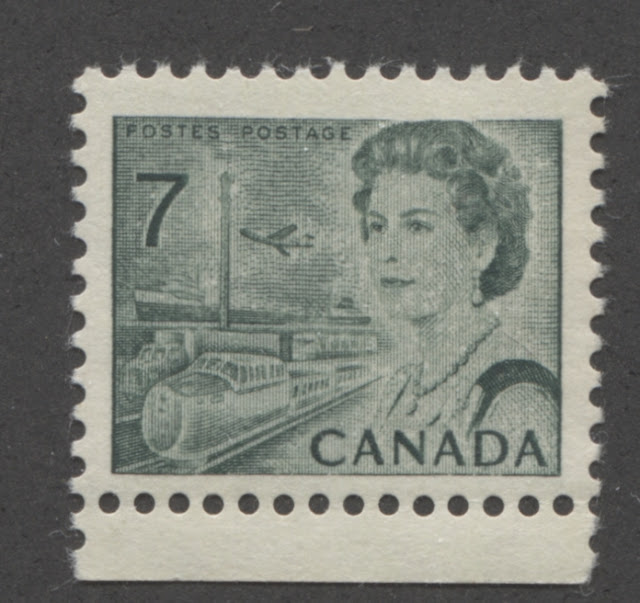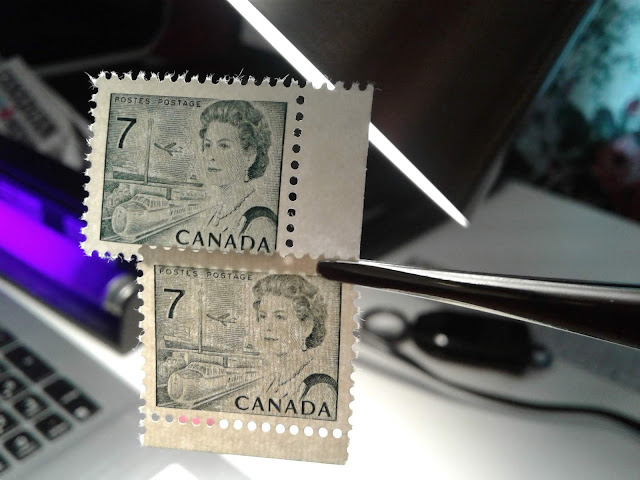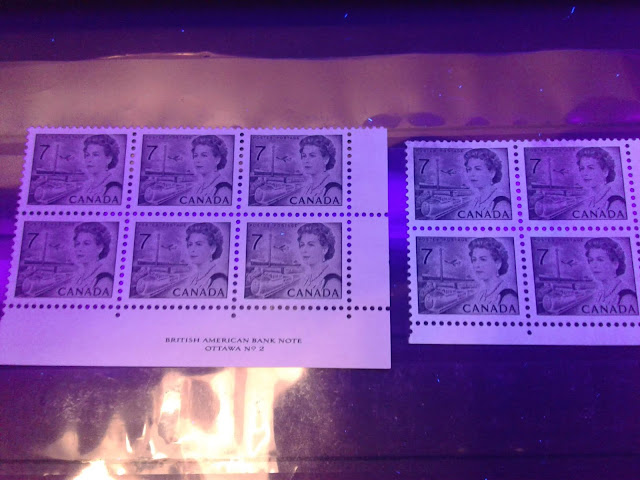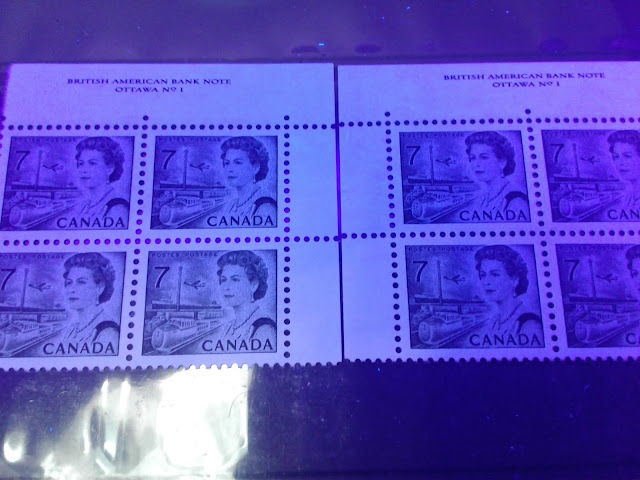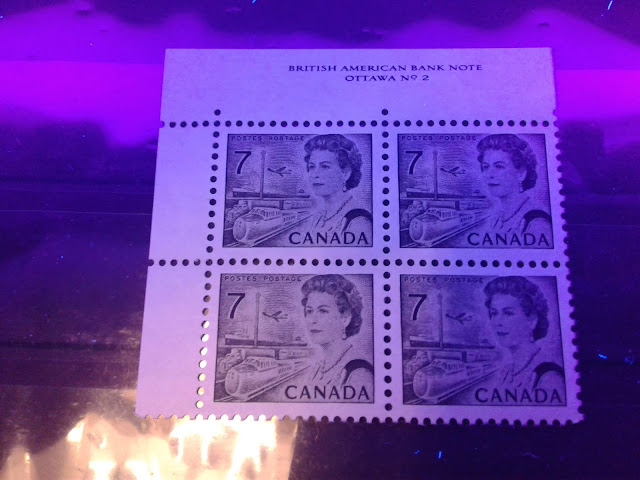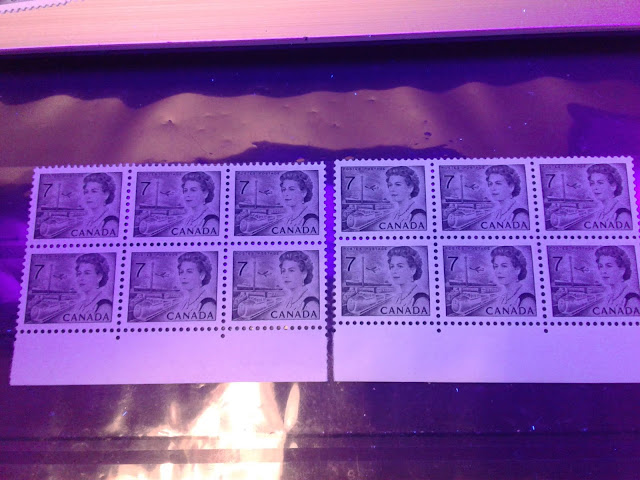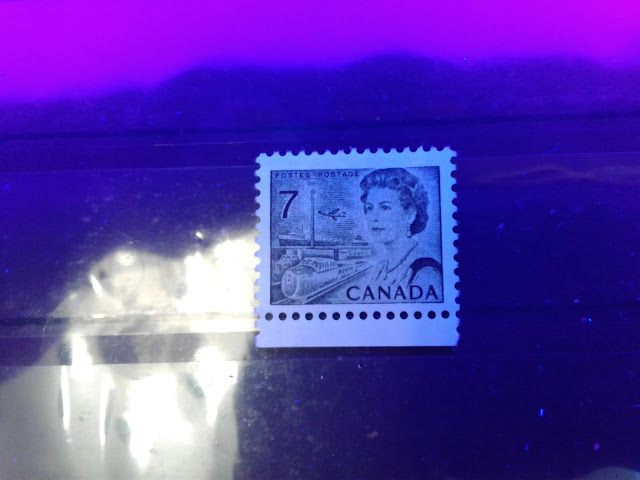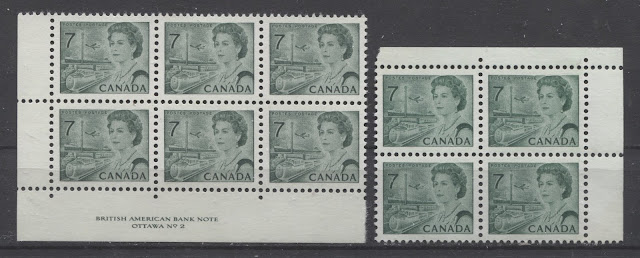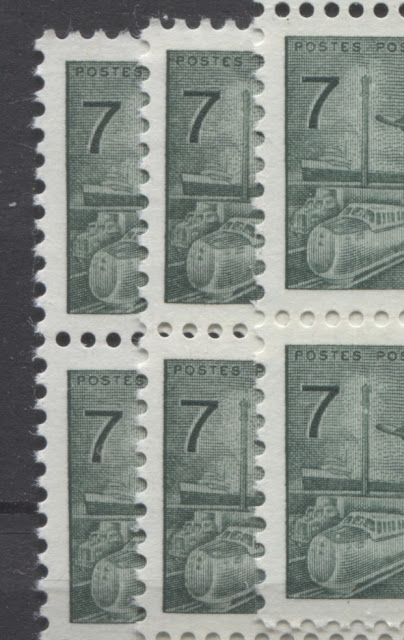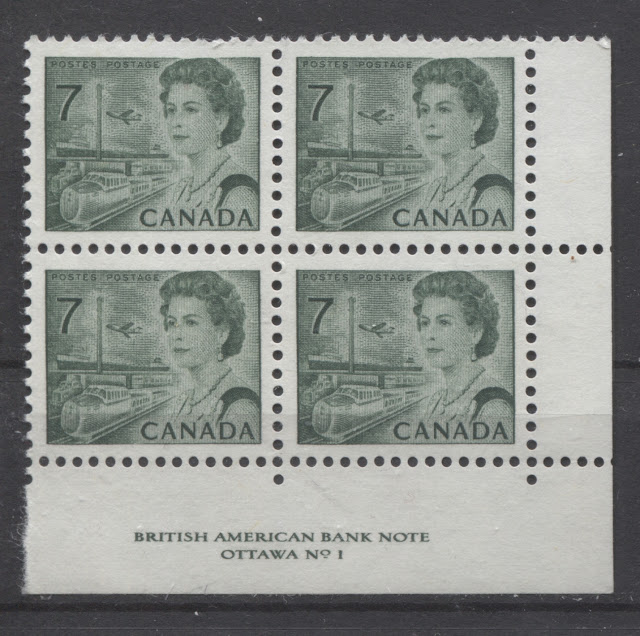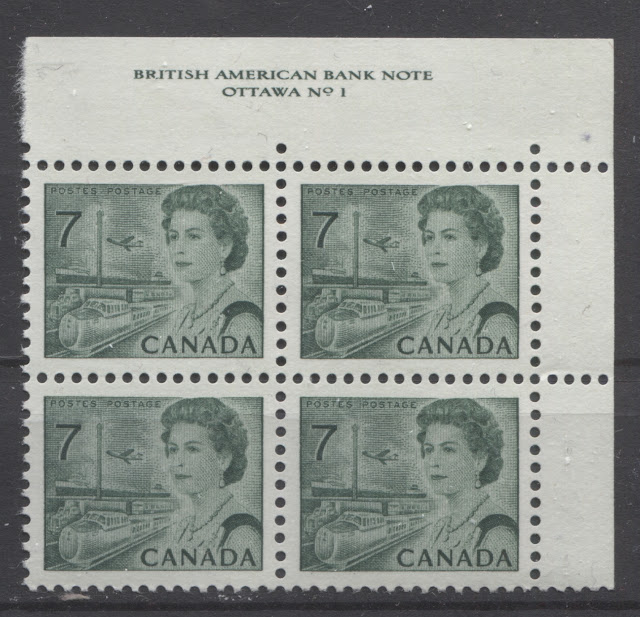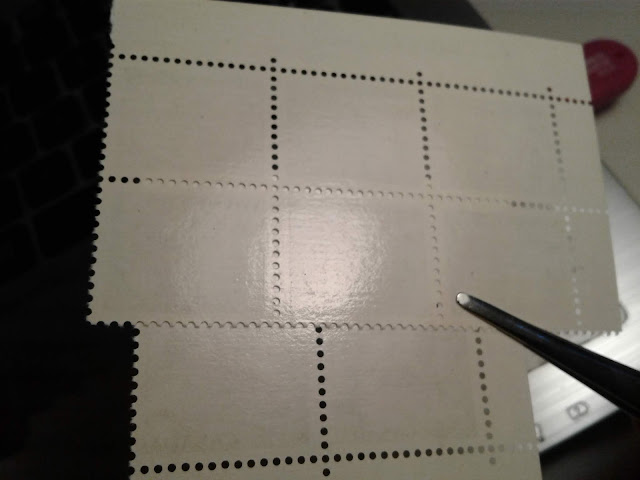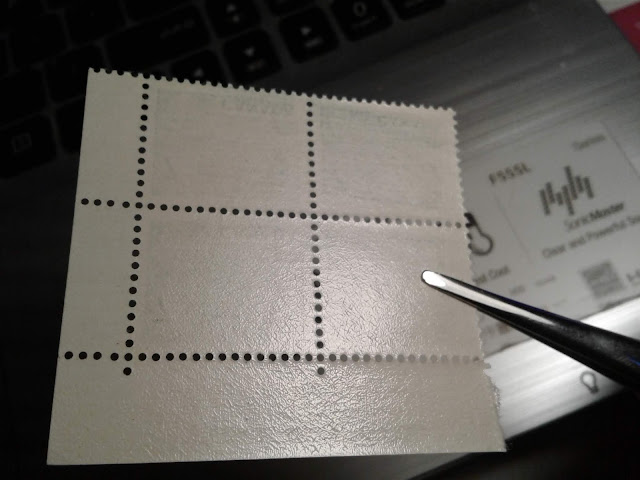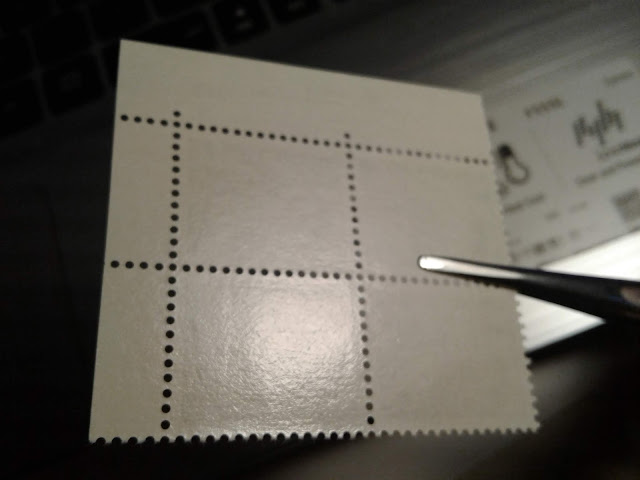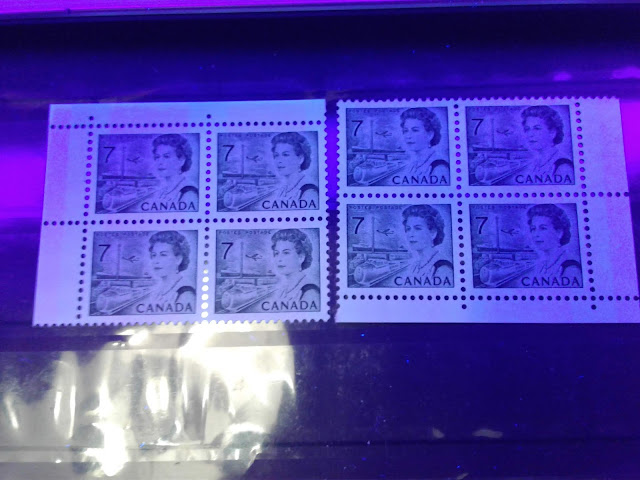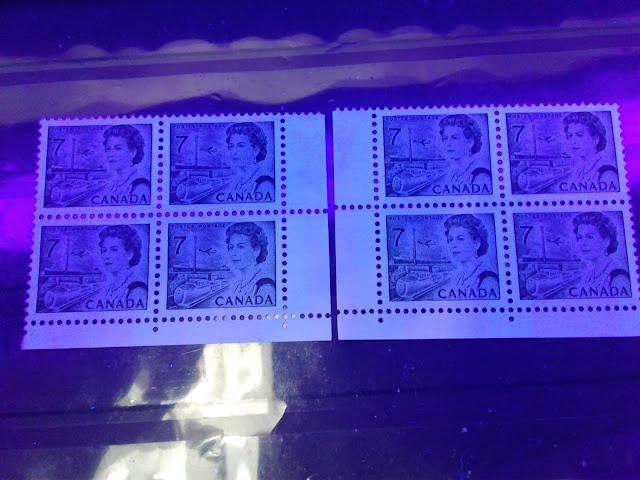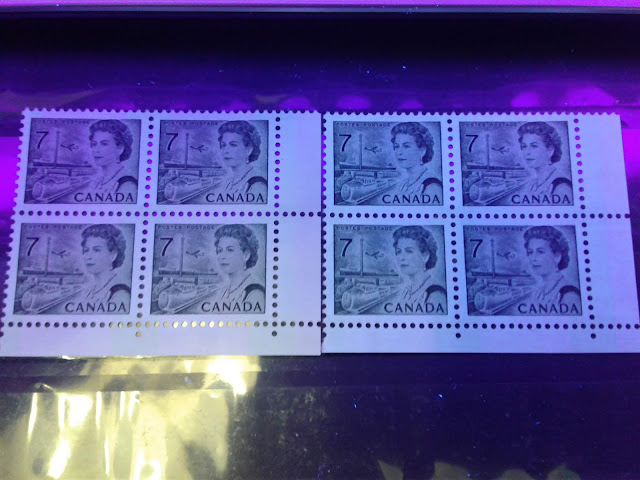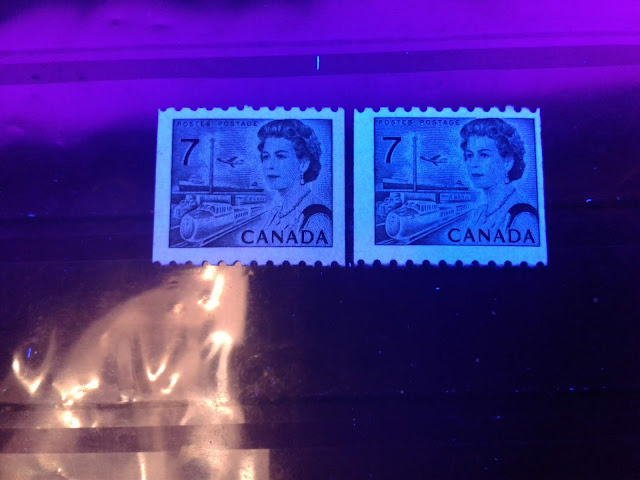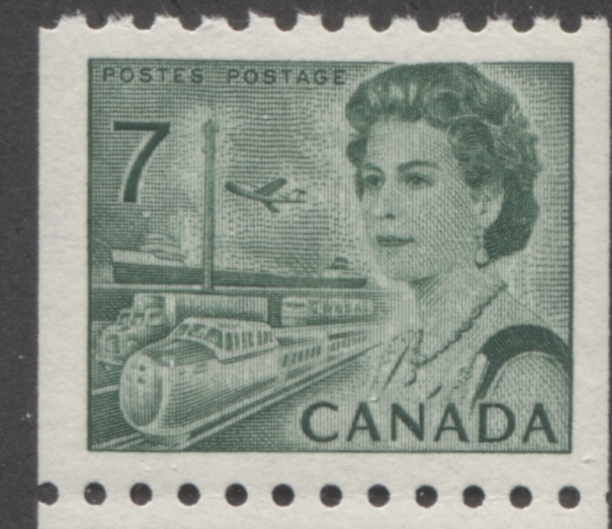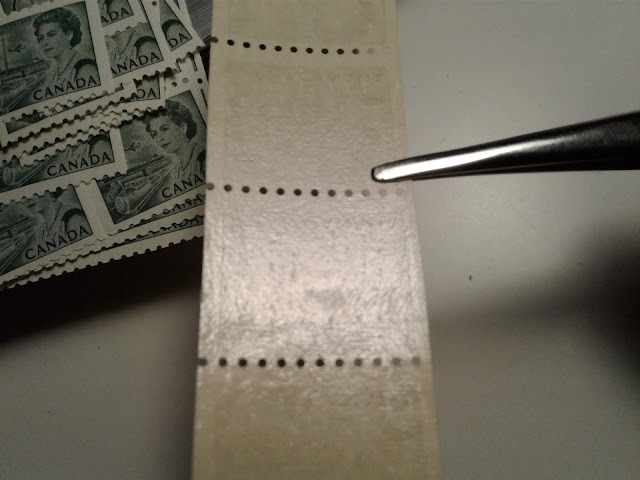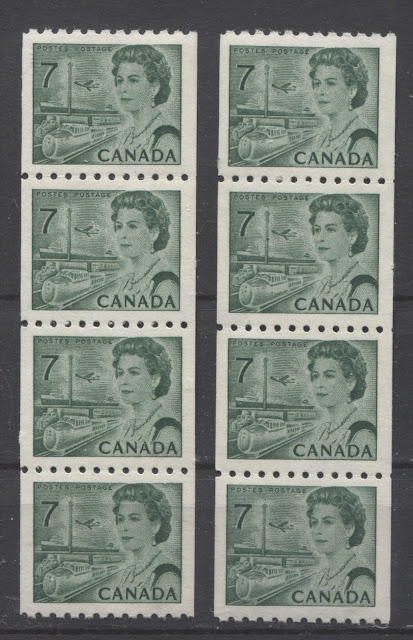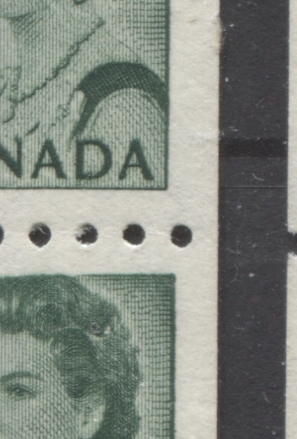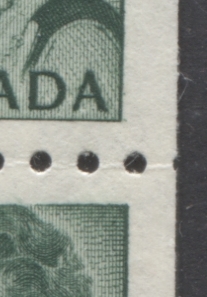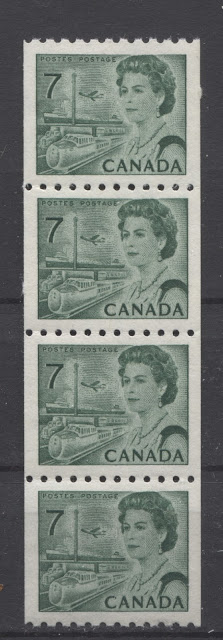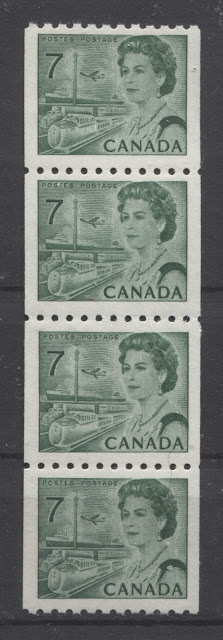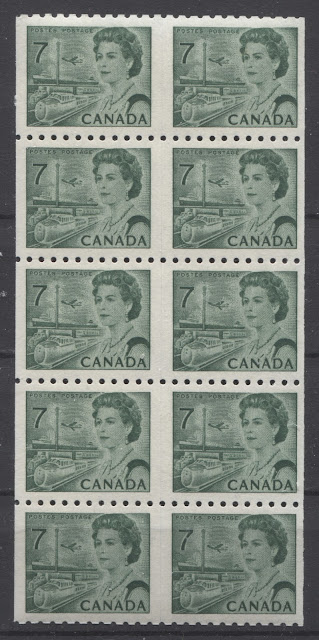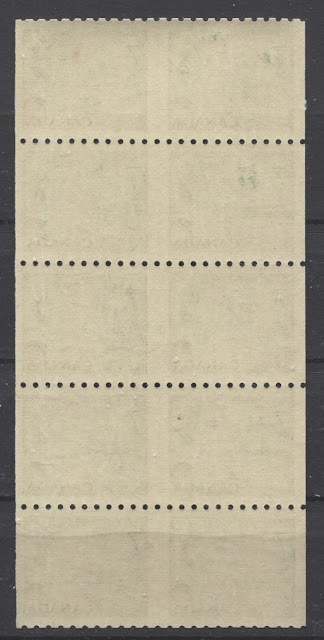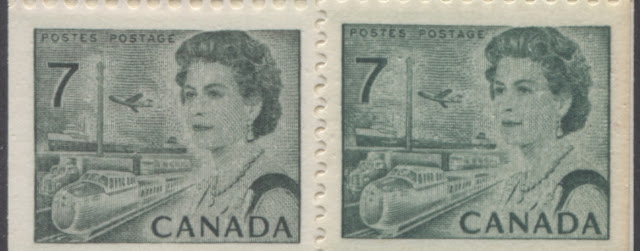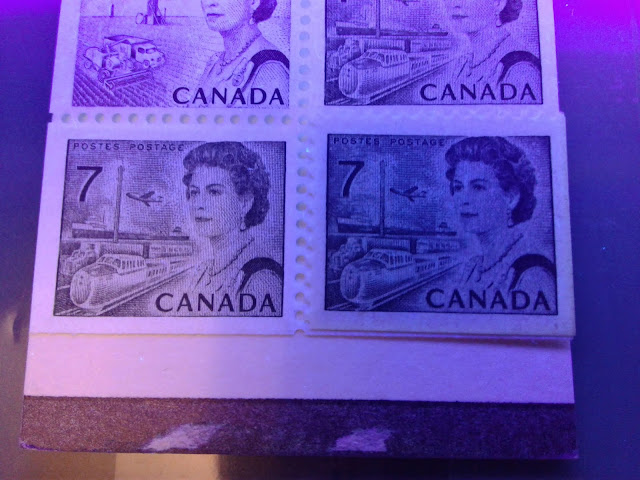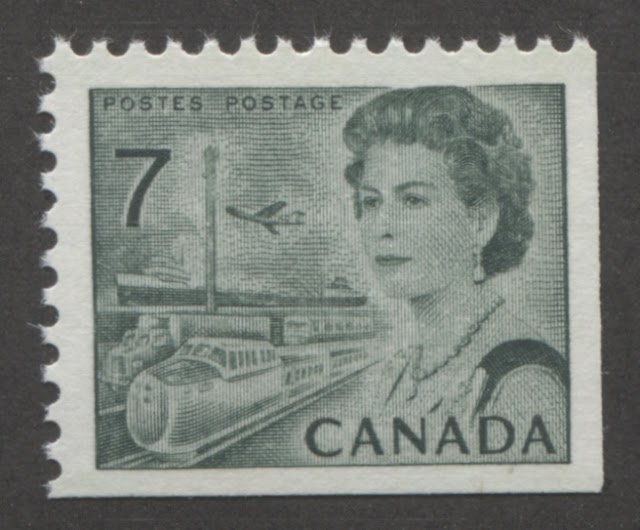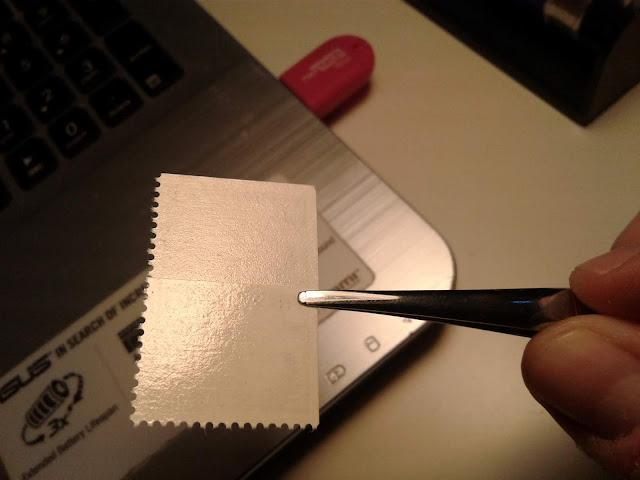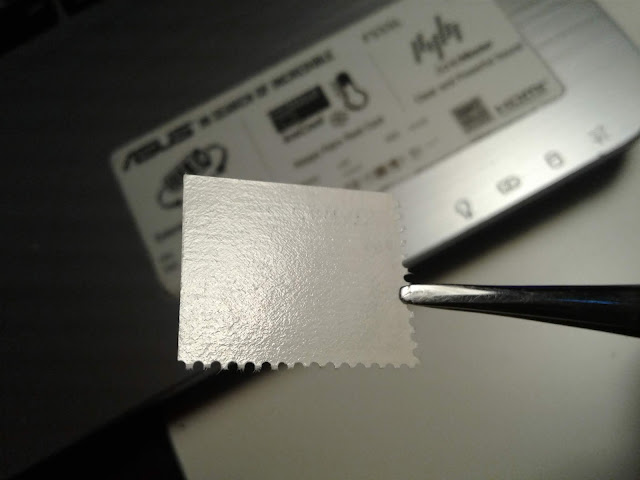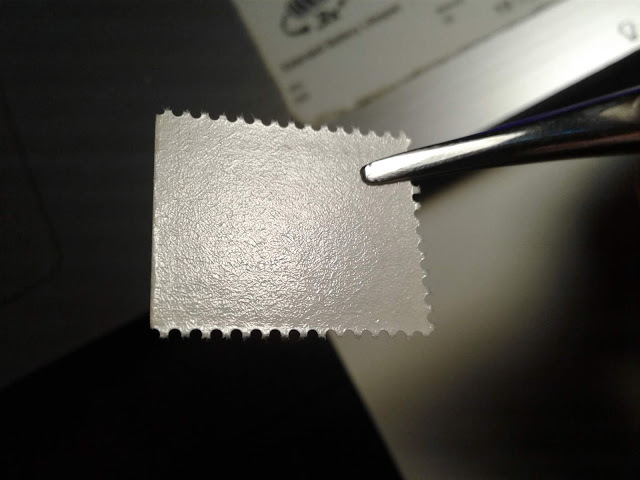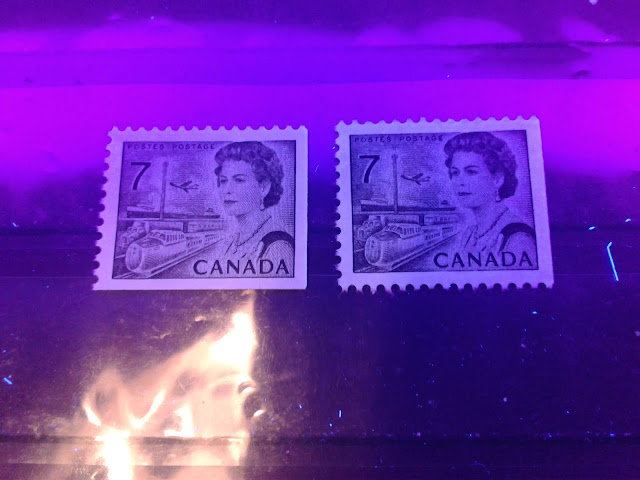Today's post deals with the shortest-lived of the stamps of this fascinating issue: the 7c emerald green transportation stamp. The issuance of this stamp was brought about because of an increase to the first class letter rate on June 30, 1971, from 6 cents to 7 cents. This rate would again be increased to 8 cents on December 30, 1971, so that this stamp had a life of exactly 6 months.
The design of the stamp was similar to the earlier 6c stamps, except that a network of fine vertical lines was added to the design, creating a very dark effect.
This stamp was issued both untagged and Winnipeg tagged in sheet form, and all of the sheet stamps known were issued with dextrose gum only. Three booklets: a 25c booklet (BK66), an experimental 50c booklet (BK68) and a $1 booklet (BK67) were issued with this stamp as one of the stamps in the booklet. The stamps from the 25c and 50c booklets are the only examples of this stamp known with PVA gum. The sheet stamps were printed from 2 plates, with plate 1 being scarcer than plate 2. There were also coil stamps that were issued in rolls of 100, just like the 6c stamps. The sheet stamps and booklet stamps were printed by the BABN and the coil stamps were printed by the CBN, just as was the case with the 6c stamps. It is also one of those stamps that up until very recently was thought to exist with few to no varieties. However, in recent years, Unitrade has begun to recognize some of the distinct paper varieties that exist. There are also at least two distinct shades of the green ink that can be found as well. However, these varieties have not, as yet gained any recognition in the catalogues.
This is another stamp that exists with a very large number of constant plate varieties. According to Unitrade, there are some 86 different cylinder flaws that exist on this stamp.
The design of the stamp was similar to the earlier 6c stamps, except that a network of fine vertical lines was added to the design, creating a very dark effect.
This stamp was issued both untagged and Winnipeg tagged in sheet form, and all of the sheet stamps known were issued with dextrose gum only. Three booklets: a 25c booklet (BK66), an experimental 50c booklet (BK68) and a $1 booklet (BK67) were issued with this stamp as one of the stamps in the booklet. The stamps from the 25c and 50c booklets are the only examples of this stamp known with PVA gum. The sheet stamps were printed from 2 plates, with plate 1 being scarcer than plate 2. There were also coil stamps that were issued in rolls of 100, just like the 6c stamps. The sheet stamps and booklet stamps were printed by the BABN and the coil stamps were printed by the CBN, just as was the case with the 6c stamps. It is also one of those stamps that up until very recently was thought to exist with few to no varieties. However, in recent years, Unitrade has begun to recognize some of the distinct paper varieties that exist. There are also at least two distinct shades of the green ink that can be found as well. However, these varieties have not, as yet gained any recognition in the catalogues.
This is another stamp that exists with a very large number of constant plate varieties. According to Unitrade, there are some 86 different cylinder flaws that exist on this stamp.
This post will look at the printings of the booklet stamps, sheet stamps and coil stamps in detail.
The Untagged Sheet Stamps - Unitrade #543
Paper Characteristics Other Than Fluorescence
There are two types of paper on the untagged stamps, although Unitrade only lists the second, scarcer type on the tagged stamps.
The first paper type is a soft, horizontal wove paper, that is very lightly coated on the printing surface, and this coating can be seen under 10x magnification. As a result, there are no stray fibres visible on the paper surface. When held up to a strong back-light, the paper shows no particular mesh pattern.
The second paper type is a coarse, uncoated horizontal wove paper. It is a deep cream colour and is vertically ribbed. When held up to a strong back-light, a very strong mesh pattern is clearly visible. The scan below shows this paper type clearly:
Unitrade lists this paper only for the tagged stamps, and not for the untagged stamps. However, as the above stamp shows, this paper does exist on the untagged stamps. It is very scarce: out of several hundred mint stamps, I have only found this single used example.
The next picture below shows a comparison between this stamp and the first paper type when viewed against strong back lighting:
As you can see, the difference between these two paper types is obvious when back lighting is used. The normal paper shows no mesh pattern at all, whereas the coarse vertically ribbed paper shows a clear vertical mesh pattern.
Paper Fluorescence
Unitrade only lists this stamp as existing on dull fluorescent paper. While it is indeed true that the fluorescence level of all papers is dull, there is a wide variety of colours which the paper takes on under UV light: from bluish white to deep grey. Some of the papers are almost bright enough to be low fluorescent, while others are almost dull enough to be non-fluorescent. The pictures below show nine different types of paper fluorescence that I have encountered on these stamps:
The block on the left is dull fluorescent bluish white under UV and contains a very sparse concentration of low fluorescent fibres, as well as very few high fluorescent fibres. The block on the right is dull fluorescent greyish, with no fluorescent fibres visible in the paper.
The block on the left is dull fluorescent greyish brown, with no fluorescent fibres visible in the paper. The block on the right is dull fluorescent white, also with no visible fluorescent fibres in the paper.
The block on the left is a dull fluorescent cream colour under UV, and contains a very sparse concentration of low fluorescent fibres. The block on the right is similar, but the colour is greyish white. In both cases, the fluorescent fibres are not noticeable until you look at the blocks very closely.
The block on the left is dull fluorescent greyish, with no fluorescent fibres visible in the paper. The block on the right is dull fluorescent ivory, with no fluorescent fibres visible in the paper.
Under UV light, the paper appears dull fluorescent greyish cream.
Shades
I have found five shades on the untagged sheet stamps. Three of them are very, very close to one another, while two are outstandingly different. I will start with the two outstandingly different shades, and then move on to the other three, similar shades.
The block on the left is the most common shade, and what Unitrade calls slate-green, while the block on the right is the emerald green shade. The shade on the left block is actually a near perfect match to Gibbons' deep grey green. The block on the right is close to Gibbons's myrtle green, but is a touch brighter.
The picture below shows the difference between the above two shades a little more clearly:
The other three shades are all variations of these first two shades. The picture below shows a close up comparison of the three, and then the individual pictures show each shade individually:
This shade is close to the deep grey-green, but with less grey in the shade. It is actually closer to myrtle green on the Gibbons colour key, being a bit deeper.
As I said earlier above, this shade is more or less the same tone as the one above, but is deeper. So this is the deep myrtle green shade.
I have found four different types of dextrose gum on the sheet stamps:
The gum types are all illustrated by the following pictures:
The high gloss gum is shown on the top block, while the semi-gloss gum is shown on the bottom block.
This picture shows the semi-gloss, semi-crackly dextrose gum.
Perforation
The sheet stamps were comb perforated 12.5 x 12. I have not found any variation in the perforation on any of the stamps I have examined. The selvage of the sheets is fully perforated through at the sides. There is a single extension hole that protrudes into the top and bottom sheet margins for the vertical perforations.
Bringing It All Together
On these stamps, I have identified two types of paper, seven levels of fluorescence, five shades and four gum types. Assuming that all varieties can exist in tandem with all other varieties, then if follows that there could be as many as 2 x 9 x 5 x 4 = 360 collectible varieties of these stamps, not counting the constant plate flaws that exist on this value. Two plates were used to print the stamps, so that there could be 8 x 360 = 2,880 collectible plate blocks, and 12 x 360 = 4,320 collectible blank corner blocks.
The Tagged Sheet Stamps - Unitrade #543p.
Paper Characteristics Other Than Fluorescence
Two paper types are known on the tagged stamps, just as with the untagged stamps: the smooth paper and the coarse, vertically ribbed paper. The only difference between these and the untagged stamps, is that Unitrade lists the ribbed paper on this variety, and lists it for more than 10 times the price of the normal smooth paper.
Paper Fluorescence
I have found five different levels of dull fluorescence on the tagged stamps - not quite as many as on the untagged. However, I have had far less material on hand to study, due to the relative scarcity of the tagged stamps. So, it wouldn't surprise me at all if the tagged stamps exist with the same levels of fluorescence as the untagged ones.
The pictures below show the varieties that I found among the blocks that I have:
The block on the left is dull fluorescent greyish white under UV, with no fluorescent fibres in the paper. The block on the right is dull fluorescent bluish white, and contains a very sparse concentration of low fluorescent fibres.
Shades
I have only found one shade of green on the tagged stamps, and it is shown below:
The shade is an exact match to Gibbons' myrtle green. Under UV light, the shade appears more or less the same - maybe a touch darker. Therefore, the ink used to print these stamps is non-transformative.
Gum
I have found two types of dextrose gum on the tagged stamps: the glossy gum and the semi-gloss gum with the horizontal striations. I have not found any tagged stamps exhibiting the other two gum types, being the crackly gum, and the semi-smooth and semi-gloss gum.
Perforation
Like the untagged stamps, these stamps were comb perforated 12.5 x 12, and the configuration of the margins on the sheets is the same as the untagged sheets:
Tagging
These stamps were tagged with Winnipeg taggant, down each vertical column of perforations. The bars are 8 mm wide, and there is a space of 16 mm in the horizontal direction between the bars. The taggant has a very light colour, just as it did on the 6c orange and the 6c black, making it very difficult to see on the stamps, as it does not discolour the paper too much. The easiest way to see it is to look for changes in the shade of green of the stamp near the right and left sides. The green will appear slightly brighter and yellower where the tagging crosses over it.
The block below shows a typical tagged corner block in normal light:
If you look in the bottom selvage, you can just make out the bars, which appear as slight discolouration in the paper, and if you look closely, you can see a very slight change in the tone of the green ink, where the tagging bars overlap it.
Under UV light, the tagging bars can either be easily visible, in the case of the dull fluorescent greyish papers, to almost invisible, on the bluish white or greyish white papers. The pictures below show the difference between the clearly visible tagging, and tagging that is almost invisible:

Here is the visible tagging. The colour is light, but on both blocks the tagging bars are clearly visible, especially on the right.
In contrast, both these blocks are tagged, but the tagging bars are almost impossible to see.
I do not believe that the difference in the visibility of the tagging bars is the result of using different chemical compounds. Rather, I believe that it results from the different paper fluorescence varieties. So, I believe that there is only one, single type of Winnipeg tagging.
Bringing It All Together
For the tagged stamps, I have identified two paper types, five types of dull fluorescence, one shade, and two types of gum. This means that there could be as many as 20 collectible varieties and up to 240 different collectible blank corner blocks.
The Coil Stamps - Unitrade #549
Paper Characteristics Other Than Fluorescence
Unlike the sheet and booklet stamps, the coil stamps are printed on vertical wove paper. The paper is uncoated and under magnification, has a porous printing surface. The paper is a light cream colour when viewed against a stark white background. There are two very similar paper types that share the above characteristics. The first of these shows no ribbing when viewed from either the front or the back, while on the second type, the horizontal mesh is clearly visible on the back and shows up as light ribbing on the gum side. The two gum side pictures below show these differences:
 Here in this picture, you can see that the gum side of this strip is completely smooth, and shows no ribbing at all.
Here in this picture, you can see that the gum side of this strip is completely smooth, and shows no ribbing at all.

In this picture, you can clearly see the horizontal mesh that is present in the paper. It is showing up as very light horizontal ribbing on the back of the stamps.
Paper Fluorescence
Unitrade only lists this stamp as existing on hibrite paper. In reality, I believe that most of the stamps printed are actually on high fluorescent paper, with some of the stamps being printed on true hibrite paper.
The scan below shows the high fluorescent paper and the true hibrite paper:
The stamp on the left is the high fluorescent paper, while the one on the right is a true hibrite paper.
Shades
I have only found one shade of green on the coil stamp, and it is shown below:
Gum
I have found two types of dextrose gum on this stamp:
Here is the smooth, yellowish cream dextrose gum. Note the semi-gloss sheen.
Perforation
These stamps are listed by Unitrade as being line perforated 10.0. I have not seen any variation in the gauge of the perforation. There are some double perforations known, but as far as I know, no variation in the size of the perforation itself.
This coil exists completely imperforate. It is quite rare, listing for $1,500 a pair in Unitrade.
Spacing Varieties
Like all the CBN printed coil stamps, this stamp exists in jump strips, as well as narrow and wide spacing strips. All of these varieties are scarcer on this value than they are on the other coil stamps, most likely because of the very short period during which this stamp was current. The normal spacing between stamp impressions in the vertical direction is 4 mm. This narrow spacing varieties tend to be 3.5 mm or narrower, while 4.5 mm or greater, suggests wide spacing. The horizontal mis-alignment between stamp impressions is quite small on the jump strips, and requires some practice and experience to spot. However, once you see it, you should be able to identify jump strips with a fair degree of accuracy.
The scans below show some jump strips, as well as a narrow spacing strip and a wide spacing strip:
Bringing It All Together
For this coil stamp, I have identified two types of paper, two levels of fluorescence and two types of gum. Each of these can be collected as a normal strip, a jump strip, a narrow spacing strip, a wide spacing strip, unsevered block, and as an imperforate pair - so 6 different ways. This means that there could be up to 2 x 2 x 2 x 6 = 48 collectible varieties of these coil stamps.
BK66 - Stamps From the June 30, 1971 25c Booklet
The Untagged Sheet Stamps - Unitrade #543
Paper Characteristics Other Than Fluorescence
There are two types of paper on the untagged stamps, although Unitrade only lists the second, scarcer type on the tagged stamps.
The first paper type is a soft, horizontal wove paper, that is very lightly coated on the printing surface, and this coating can be seen under 10x magnification. As a result, there are no stray fibres visible on the paper surface. When held up to a strong back-light, the paper shows no particular mesh pattern.
The second paper type is a coarse, uncoated horizontal wove paper. It is a deep cream colour and is vertically ribbed. When held up to a strong back-light, a very strong mesh pattern is clearly visible. The scan below shows this paper type clearly:
Unitrade lists this paper only for the tagged stamps, and not for the untagged stamps. However, as the above stamp shows, this paper does exist on the untagged stamps. It is very scarce: out of several hundred mint stamps, I have only found this single used example.
The next picture below shows a comparison between this stamp and the first paper type when viewed against strong back lighting:
As you can see, the difference between these two paper types is obvious when back lighting is used. The normal paper shows no mesh pattern at all, whereas the coarse vertically ribbed paper shows a clear vertical mesh pattern.
Paper Fluorescence
Unitrade only lists this stamp as existing on dull fluorescent paper. While it is indeed true that the fluorescence level of all papers is dull, there is a wide variety of colours which the paper takes on under UV light: from bluish white to deep grey. Some of the papers are almost bright enough to be low fluorescent, while others are almost dull enough to be non-fluorescent. The pictures below show nine different types of paper fluorescence that I have encountered on these stamps:
The block on the left is dull fluorescent bluish white under UV and contains a very sparse concentration of low fluorescent fibres, as well as very few high fluorescent fibres. The block on the right is dull fluorescent greyish, with no fluorescent fibres visible in the paper.
The block on the left is dull fluorescent greyish brown, with no fluorescent fibres visible in the paper. The block on the right is dull fluorescent white, also with no visible fluorescent fibres in the paper.
The block on the left is a dull fluorescent cream colour under UV, and contains a very sparse concentration of low fluorescent fibres. The block on the right is similar, but the colour is greyish white. In both cases, the fluorescent fibres are not noticeable until you look at the blocks very closely.
This paper is dull fluorescent greyish white, with no fluorescent fibres in the paper at all.
The block on the left is dull fluorescent greyish, with no fluorescent fibres visible in the paper. The block on the right is dull fluorescent ivory, with no fluorescent fibres visible in the paper.
This picture does not show it well, but the right stamp is dull fluorescent yellowish cream, with no fluorescent fibres visible in the paper. The pair on the left is dull fluorescent greyish white with a very sparse concentration of low fluorescent fibres.
I have only found one example of the coarse, vertically ribbed paper, and it is shown below:
Under UV light, the paper appears dull fluorescent greyish cream.
Shades
I have found five shades on the untagged sheet stamps. Three of them are very, very close to one another, while two are outstandingly different. I will start with the two outstandingly different shades, and then move on to the other three, similar shades.
The block on the left is the most common shade, and what Unitrade calls slate-green, while the block on the right is the emerald green shade. The shade on the left block is actually a near perfect match to Gibbons' deep grey green. The block on the right is close to Gibbons's myrtle green, but is a touch brighter.
The picture below shows the difference between the above two shades a little more clearly:
The other three shades are all variations of these first two shades. The picture below shows a close up comparison of the three, and then the individual pictures show each shade individually:
The shades on the left and the right are very similar to one another, but the stamps on the right contain a little more green and a little less grey. You can see the difference clearly if you relax your gaze a little bit. The middle block is the same overall tone as the left block, but the shade is a little bit deeper. Now, let's look at each of these blocks individually:
This shade is close to the deep grey-green, but with less grey in the shade. It is actually closer to myrtle green on the Gibbons colour key, being a bit deeper.
As I said earlier above, this shade is more or less the same tone as the one above, but is deeper. So this is the deep myrtle green shade.
This shade is clearly greener and less grey than any of the grey-green or regular myrtle green shades. It is actually a perfect match to the pure myrtle green on the Gibbons colour key.
Under UV light, the shades generally appear darker, but are all basically still shades of green. Therefore, the inks used to print these stamps are non-transformative.
GumI have found four different types of dextrose gum on the sheet stamps:
- A very glossy cream gum that usually has fine horizontal striations that resemble brush strokes.
- A semi-gloss cream gum that also has fine horizontal striations, but is not as glossy as the first type of gum.
- A semi-gloss cream gum that has fine horizontal striations, but also appears somewhat crackly.
- A crackly cream gum with a fine diagonal crack pattern and a semi-gloss sheen.
The gum types are all illustrated by the following pictures:
The high gloss gum is shown on the top block, while the semi-gloss gum is shown on the bottom block.
This picture shows the crackly gum.
This picture shows the semi-gloss, semi-crackly dextrose gum.
Perforation
The sheet stamps were comb perforated 12.5 x 12. I have not found any variation in the perforation on any of the stamps I have examined. The selvage of the sheets is fully perforated through at the sides. There is a single extension hole that protrudes into the top and bottom sheet margins for the vertical perforations.
Bringing It All Together
On these stamps, I have identified two types of paper, seven levels of fluorescence, five shades and four gum types. Assuming that all varieties can exist in tandem with all other varieties, then if follows that there could be as many as 2 x 9 x 5 x 4 = 360 collectible varieties of these stamps, not counting the constant plate flaws that exist on this value. Two plates were used to print the stamps, so that there could be 8 x 360 = 2,880 collectible plate blocks, and 12 x 360 = 4,320 collectible blank corner blocks.
The Tagged Sheet Stamps - Unitrade #543p.
Paper Characteristics Other Than Fluorescence
Two paper types are known on the tagged stamps, just as with the untagged stamps: the smooth paper and the coarse, vertically ribbed paper. The only difference between these and the untagged stamps, is that Unitrade lists the ribbed paper on this variety, and lists it for more than 10 times the price of the normal smooth paper.
Paper Fluorescence
I have found five different levels of dull fluorescence on the tagged stamps - not quite as many as on the untagged. However, I have had far less material on hand to study, due to the relative scarcity of the tagged stamps. So, it wouldn't surprise me at all if the tagged stamps exist with the same levels of fluorescence as the untagged ones.
The pictures below show the varieties that I found among the blocks that I have:
The block on the left is a dull fluorescent grey, with a slight purple undertone. There are no fluorescent fibres visible inside the paper at all. The block on the right is a slightly paler grey colour without any purple undertone.
The block on the left is dull fluorescent greyish white under UV, with no fluorescent fibres in the paper. The block on the right is dull fluorescent bluish white, and contains a very sparse concentration of low fluorescent fibres.
These blocks are both dull fluorescent greyish white and contain a very sparse concentration of low fluorescent fibres that are visible in the paper.
Shades
I have only found one shade of green on the tagged stamps, and it is shown below:
The shade is an exact match to Gibbons' myrtle green. Under UV light, the shade appears more or less the same - maybe a touch darker. Therefore, the ink used to print these stamps is non-transformative.
Gum
I have found two types of dextrose gum on the tagged stamps: the glossy gum and the semi-gloss gum with the horizontal striations. I have not found any tagged stamps exhibiting the other two gum types, being the crackly gum, and the semi-smooth and semi-gloss gum.
Perforation
Like the untagged stamps, these stamps were comb perforated 12.5 x 12, and the configuration of the margins on the sheets is the same as the untagged sheets:
- The side margins are perforated all the way through.
- The top and bottom margins contain a single extension hole that protrudes beyond the top horizontal row of perforations and below the bottom horizontal row of perforations.
Tagging
These stamps were tagged with Winnipeg taggant, down each vertical column of perforations. The bars are 8 mm wide, and there is a space of 16 mm in the horizontal direction between the bars. The taggant has a very light colour, just as it did on the 6c orange and the 6c black, making it very difficult to see on the stamps, as it does not discolour the paper too much. The easiest way to see it is to look for changes in the shade of green of the stamp near the right and left sides. The green will appear slightly brighter and yellower where the tagging crosses over it.
The block below shows a typical tagged corner block in normal light:
If you look in the bottom selvage, you can just make out the bars, which appear as slight discolouration in the paper, and if you look closely, you can see a very slight change in the tone of the green ink, where the tagging bars overlap it.
Under UV light, the tagging bars can either be easily visible, in the case of the dull fluorescent greyish papers, to almost invisible, on the bluish white or greyish white papers. The pictures below show the difference between the clearly visible tagging, and tagging that is almost invisible:

Here is the visible tagging. The colour is light, but on both blocks the tagging bars are clearly visible, especially on the right.
In contrast, both these blocks are tagged, but the tagging bars are almost impossible to see.
I do not believe that the difference in the visibility of the tagging bars is the result of using different chemical compounds. Rather, I believe that it results from the different paper fluorescence varieties. So, I believe that there is only one, single type of Winnipeg tagging.
Bringing It All Together
For the tagged stamps, I have identified two paper types, five types of dull fluorescence, one shade, and two types of gum. This means that there could be as many as 20 collectible varieties and up to 240 different collectible blank corner blocks.
The Coil Stamps - Unitrade #549
Paper Characteristics Other Than Fluorescence
Unlike the sheet and booklet stamps, the coil stamps are printed on vertical wove paper. The paper is uncoated and under magnification, has a porous printing surface. The paper is a light cream colour when viewed against a stark white background. There are two very similar paper types that share the above characteristics. The first of these shows no ribbing when viewed from either the front or the back, while on the second type, the horizontal mesh is clearly visible on the back and shows up as light ribbing on the gum side. The two gum side pictures below show these differences:


In this picture, you can clearly see the horizontal mesh that is present in the paper. It is showing up as very light horizontal ribbing on the back of the stamps.
Paper Fluorescence
Unitrade only lists this stamp as existing on hibrite paper. In reality, I believe that most of the stamps printed are actually on high fluorescent paper, with some of the stamps being printed on true hibrite paper.
The scan below shows the high fluorescent paper and the true hibrite paper:
The stamp on the left is the high fluorescent paper, while the one on the right is a true hibrite paper.
Shades
I have only found one shade of green on the coil stamp, and it is shown below:
This is a very close match to Gibbons's myrtle green, but is perhaps just a touch brighter.
Gum
I have found two types of dextrose gum on this stamp:
- A smooth yellowish cream gum with a semi-gloss sheen.
- A slightly streaky yellowish cream gum with a semi-gloss sheen.
The pictures below show both types:
Here is the smooth, yellowish cream dextrose gum. Note the semi-gloss sheen.
Here is the slightly streaky gum. Note the tiny blemishes in the gum.
Perforation
These stamps are listed by Unitrade as being line perforated 10.0. I have not seen any variation in the gauge of the perforation. There are some double perforations known, but as far as I know, no variation in the size of the perforation itself.
This coil exists completely imperforate. It is quite rare, listing for $1,500 a pair in Unitrade.
Spacing Varieties
Like all the CBN printed coil stamps, this stamp exists in jump strips, as well as narrow and wide spacing strips. All of these varieties are scarcer on this value than they are on the other coil stamps, most likely because of the very short period during which this stamp was current. The normal spacing between stamp impressions in the vertical direction is 4 mm. This narrow spacing varieties tend to be 3.5 mm or narrower, while 4.5 mm or greater, suggests wide spacing. The horizontal mis-alignment between stamp impressions is quite small on the jump strips, and requires some practice and experience to spot. However, once you see it, you should be able to identify jump strips with a fair degree of accuracy.
The scans below show some jump strips, as well as a narrow spacing strip and a wide spacing strip:
The above scan shows two jump strips. On the left strip, the jump occurs between the middle stamps. On the right strip the jump occurs between the top and second stamp from the top. The enlarged scans below show these jumps more clearly:
Here you can clearly see that the top stamp ends just before the bottom one on the right. This is most apparent by the fact that the right margin on the top stamp is slightly wider than the bottom stamp.
Here we can see the same thing on the top stamp, where the margin is wider at the right than it is on the bottom stamp.
The next scan shows a narrow spacing strip:
This variety can be difficult to spot, but if you look carefully at this strip, you will notice that the gap between the top stamps is noticeably narrower than the gap between the other stamps. It is 3.5 mm compared to 4.0 mm for the other stamps.
The next scan shows a wide spacing strip. See if you can see where the wide spacing is:
Here, the wide spacing is between the middle stamps, where the spacing is 4.5 mm compared with the normal 4.0 mm.
Unsevered Blocks
Like the 6c orange and 6c black, these coil stamps were produced in large sheets that scored in between the columns of stamps, and were rolled up into rolls of 100 stamps, that were joined together. The rolls were then snapped apart at the score lines to give a complete roll of stamps. However, it was possible to unroll two or more unbroken rolls and obtain blocks that appeared to be for all intents and purposes partially imperforate. They are not partially imperforate though, as the score line is present between the vertical strips in such a block. Blocks in which there is no trace of the scoreline present are genuine partially imperforate errors, and are very scarce, and worth significant premiums. The scored blocks however, are more of a novelty and not really worth a significant premium, although they are fun to collect. The scans below show a typical unsevered block with a visible vertical scoreline on the front:
On this block, you can see a small slub of paper on the upper left stamp, where the coil rolls that this was attached to were snapped apart. The scoreline appears quite faint in the above picture. However, it should be noted that it is quite visible in reality. Hopefully, the following close-up scan will show the scoreline a bit more clearly:
Here you can clearly see the scoreline in the above scan. On genuine part imperf blocks, you would not see a line like this. The scoreline does not penetrate all the way through the paper, so that it is not visible on the back of the blocks. The following scan shows the back of the above block, and as you can see, there is no clear scoreline:
Bringing It All Together
For this coil stamp, I have identified two types of paper, two levels of fluorescence and two types of gum. Each of these can be collected as a normal strip, a jump strip, a narrow spacing strip, a wide spacing strip, unsevered block, and as an imperforate pair - so 6 different ways. This means that there could be up to 2 x 2 x 2 x 6 = 48 collectible varieties of these coil stamps.
BK66 - Stamps From the June 30, 1971 25c Booklet
Shades
There are two basic shades of green found on the stamps from these booklets. There is confusion surrounding the shade names, as Unitrade calls the colour of this stamp slate green, while McCann and other literature refer to the colour as emerald green. In actual fact, both shades exist. The stamp on the left is what the catalogues would generally refer to as slate green, but in reality it is an exact match to bottle green on the Gibbons colour key. The stamp on the right is definitely emerald in tone, but it is much deeper than the emerald green shown on the Gibbons colour key.
Under UV light, the shades appear deeper and contain a hint of black, but are still identifiable as shades of green:
Under UV light, the shades appear deeper and contain a hint of black, but are still identifiable as shades of green:
Therefore, the inks are non-transformative in nature.
Paper
The paper used to print these stamps is very hard and stiff, at least when the gum is on. The paper bends easiest in the vertical direction, which indicates that it is a vertical wove. There is a light vertical ribbing on the surface, which is easiest to see when the stamps are viewed against strong back-lighting. Under magnification, the paper appears uncoated and although smooth, there are, what appear to be minute loose fibres on the surface. The paper is strongly cream coloured, when viewed against a white background.
Gum
The gum used on these booklets is a smooth PVA that had a satin sheen, and an obvious cream colour. This is easiest to see, by showing it next to one of the later printings made with white PVA gum, from BK69:
The pair shown on the left is the same pair shown in the first scan, while the one on the right is a pair from BK69, which has a much whiter PVA gum.
Paper Fluorescence
Unitrade lists only two grades of fluorescence on these stamps: low fluorescent (LF) and medium fluorescent (MF), while McCann lists these, in addition for dull fluorescent. All three of these descriptions are a little inadequate, I find, because they ignore the fluorescent fibres that are visible in the paper as well as the brownish woodpulp flecks.
The basic colour of the paper under UV is a light violet grey on the front and a bluish white on the back. All through the paper are brownish woodpulp flecks, that become visible when you look at the paper very closely under UV. There are fluorescent fibres embedded in the paper that vary both in brightness, and density. It is these variations that give the paper its overall appearance:
- A sparse to very sparse density of dull fluorescent fibres results in paper that McCann calls "dull". It is much scarcer than either the low fluorescent or medium fluorescent papers.
- A low density concentration of dull fluorescent fibres and a very sparse concentration of medium fluorescent fibres results in the low fluorescent paper, which is the most common paper found on these booklets.
- A higher density of medium fluorescent fibres results in the so called medium fluorescent paper.
The paper of the stamps containted in the other booklets do not show the brownish woodpulp flecks so clearly. A loupe is required to see them clearly, but they are much, much more prominent on the stamps from this booklet than any other.
Tagging
All of the stamps from these booklets are untagged.
BK67 - Stamps From the June 30, 1971 $1 Booklet
Shades
The stamps from this booklet appear to be about mid way in shade between the bottle green and deep emerald green that we saw above for the stamps from BK66. The actual shade is a perfect match to Gibbons' deep grey-green on the colour key.
Paper
The paper of the stamps from this booklet has a soft feel to it. It bends easily in the horizontal direction, so it is horizontal wove. Under magnification it has a smooth, uncoated surface and is never ribbed on either the front or the back. When viewed against a white background, the colour of the paper is a creamy off-white. No mesh is visible, when the paper is viewed against strong back-lighting.
Gum
These stamps only exist with dextrose gum. I have found three different types of dextrose gum on these stamps:
In this picture, the top stamp shows the crackly gum, while the bottom stamp shows the glossy gum.
Here is the semi-gloss, semi-crackly gum. Note the very fine horizontal striations visible at the top of the stamp.
- A cream gum with a glossy sheen, that has light horizontal striations, resembling brushstrokes.
- A cream gum that is smooth, but somewhat crackly, with light horizontal striations. This gum has a semi-gloss sheen.
- A cream gum that is smooth, but crackly, with a very fine diagonal crack pattern. This gum has a satin sheen.
The picture below shows the difference between the first and third gum types, and the next two pictures show the two non-glossy gum types:
In this picture, the top stamp shows the crackly gum, while the bottom stamp shows the glossy gum.
Here is the semi-gloss, semi-crackly gum. Note the very fine horizontal striations visible at the top of the stamp.
Here is a closer picture of the crackly gum. Note the complete lack of any striations on the gum.
I have found two varieties of fluorescence on these stamps. All of the booklets and stamps that I have examined are dull fluorescent paper, but one variety appears greyish under UV, while the other appears greyish white. The stamp on the left appears greyish, while the stamp on the right appears greyish white.
Tagging
None of the stamps from these booklets are tagged.
BK68 - Stamps From the August 50c Experimental Toronto Booklet
These booklets were simply made by taking BK66 and gluing an additional pane into the front cover to make a 50c booklet. Consequently, the physical properties of the stamps are exactly the same as they are for all the BK66 stamps that I observed.
Conclusions: Sorting Single Booklet Stamps
As we have seen, despite the apparent similarities of the booklet stamps, there are characteristics of each booklet that allow us to assign individual stamps to a particular booklet. The only exception to this is possibly BK68, which used the exact same panes as BK66, so it is only possible to assign singles to either BK66 or BK68.
If you have pairs of stamps from a booklet, it may possible to assign those to a particular booklet right away, based on the layout of the stamps, which are specific to a particular type of booklet:
This brings me to the end of my exploration of the 7c transportation stamp. Next week I will begin a new series of four posts, which will deal with the last, and most complicated of the low values from the set: the 8c parliamentary library.
Conclusions: Sorting Single Booklet Stamps
As we have seen, despite the apparent similarities of the booklet stamps, there are characteristics of each booklet that allow us to assign individual stamps to a particular booklet. The only exception to this is possibly BK68, which used the exact same panes as BK66, so it is only possible to assign singles to either BK66 or BK68.
If you have pairs of stamps from a booklet, it may possible to assign those to a particular booklet right away, based on the layout of the stamps, which are specific to a particular type of booklet:
- A vertical pair of the 1c and 7c can only come from BK 66 or BK68.
- A vertical pair of the 3c and 7c with a straight edge on the bottom of the 7c must come from either BK66 or BK68.
- A vertical pair of the 3c and 7c with a straight edge at only right or left must come from BK67.
- A vertical pair of the 7c with straight edge at only right or left must come from BK67.
In terms of sorting singles, the gum is the best attribute to start with, if you are sorting mint stamps:
- If the gum is a cream coloured PVA gum with a satin sheen, it is from either BK66 or BK68.
- If the gum is dextrose gum, then it is from BK67.
All of the stamps from these booklets are printed on cream paper. However, they can be sorted into horizontal and vertical wove paper depending on which direction the paper bends most easily, without creasing. Horizontal wove will come from BK67. The vertical wove papers will all be either BK66 or BK68, and they should be ribbed vertically.
This brings me to the end of my exploration of the 7c transportation stamp. Next week I will begin a new series of four posts, which will deal with the last, and most complicated of the low values from the set: the 8c parliamentary library.


